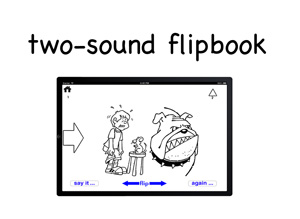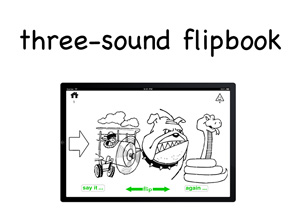Three Purposes for the Flipbooks
First
To allow the child to learn the sounds. Dekodiphukan introduces the sound images and provides the rationale for why each image represents the sound that it does. However, sounds are learned best in the context of words and not in isolation. The Two and Three-Sound Flipbooks allow the child to hear and learn the sounds in words.
Second
To allow the parent or teacher to model for the child the process of blending sounds into words. Audios are provided to assist the parent in learning the blending process and to permit the child to review the process on his or her own as often as he or she may wish.
The blending or slurring of sounds into words takes practice. Just knowing how to say the sounds is not enough. As an example, the sounds for the word stir are    . Said separately and spaced apart, they hardly sound like the word stir at all. For the sounds to become the word stir they must be said quickly, one after the other and slurred together. The Two and Three-Sound Flipbooks help the teacher or parent teach the child this blending or slurring process. . Said separately and spaced apart, they hardly sound like the word stir at all. For the sounds to become the word stir they must be said quickly, one after the other and slurred together. The Two and Three-Sound Flipbooks help the teacher or parent teach the child this blending or slurring process.
Third
To insure the child has the vocabulary to proceed independently in the reading program. If the two or three sounds the child is blending form a word that he or she does not know, the child has little hope of knowing if his or her blending is correct. The child learns to blend sounds into words using only words that are a part of his or her vocabulary.
Page Codings
Each Flipbook page contains a page number (top left-hand corner) and a number coding (top right-hand corner). The number coding indicates the number of sounds introduced in Dekodiphukan. For example, the number 5 means that for this word to be read, the child must have been introduced to at least the first 5 sounds in Dekodiphukan. As additional sounds are learned, more words may be added to the ones with which the child may practice his or her blending.
The number codings are accompanied by the triangle, circle, square, rectangle, and star symbols that identify the five levels of the program. When all of the Two-Sound Flipbook triangle words have been introduced, the child will have the necessary word vocabulary to begin the two-sound triangle level activities in the program's other apps. When all of the Three-Sound Flipbook happy-face triangle words have been introduced, the child will have the word vocabulary needed to begin the three-sound triangle level activities in the other apps, and so on.
Sample Parent Dialog
Here is a sample of what the parent can say to the child while presenting a Flipbook page. As much as the child is able, the child says the sounds and words along with the parent:
"See the arrow? The arrow tells us where to start.
“Say the sounds with me as I slide my finger beneath the sounds."
"Sounding out 'ear'......eeeeeeeeeee rrrrrrrrrrrr…..ear"
"Say it fast......eeeeeeeeeeerrrrrrr….ear."
The Next Word
Sliding a finger sideways on the iPad screen will advance to the next word. To keep from advancing to the next word while sliding a finger beneath the sounds, the sliding finger should be placed on the black or white (depending on the iPad model) edge of the iPad beneath the screen rather than on the screen itself. It is important to slide the finger beneath each sound as it is being said, rather than stopping and pointing to each sound individually.
Sample Dialog Continued
''There is a picture of the word we just read on the other side of this page. What do you think we will see when we flip the page to see the picture?"
Procedure
The procedure for showing children how to blend words is:
1) Look at the two or three sound word
2) Focus attention on beginning at the arrow
3) Say the word to be blended (important!) and have the child say the sounds with you as you slowly slide your finger beneath the sounds
4) Repeat the blending, beginning again at the arrow
5) ''Say it fast" as you move your finger quickly across the edge of the iPad to blend the sounds into their word
6) Ask the child what picture he or she expect to see when the page is flipped
7) Touch the flip-arrow to flip to the picture
8) Discuss the meaning of the word
9) Touch the flip-arrow again to return to the word
10) Slide to the next word and repeat steps 1 through 9
Slow and Fast Sounds
The process of stretching out the sounds and saying them slowly works well with sounds like  or or  . These sounds can be referred to as slow sounds, because they can be stretched out and said slowly. Sounds like . These sounds can be referred to as slow sounds, because they can be stretched out and said slowly. Sounds like  or or  , on the other hand, cannot be stretched out and said slowly. These sounds may be said to be fast sounds. We can talk to children about the difference between slow and fast sounds and which sounds are which as each new sound is introduced. , on the other hand, cannot be stretched out and said slowly. These sounds may be said to be fast sounds. We can talk to children about the difference between slow and fast sounds and which sounds are which as each new sound is introduced.
Blending
Blending sounds into words must be taught. It does not occur spontaneously. Children do not see a word left to right. They see it all at once. Without specific training, children are as apt to read the sounds right to left as they are to read from left to right. This is why blending always starts with the parent, teacher, or child's finger pointing to the arrow at the beginning of each word. In addition, children are taught to point to the sounds as they say them to train their eyes in the correct left to right sequence. Sliding a finger beneath the sounds as they are being said, as opposed to stopping the finger on each sound, visually reinforces the notion that the sounds are to flow together to form the word they represent.
Expectations
It is not expected that the child will be able, on his or her own, to read every triangle word before beginning the triangle level activities in the apps that follow. What is expected is that the triangle level words in the Two and Three-Sound Flipbooks will have become part of the child’s vocabulary.
The Two and Three-Sound Flipbooks introduce the child to the process of blending sounds into words. Just as importantly, they insure that the child has the vocbularly necessary to recognize the words being read.
The more familiar the child is with the words he or she is asked to blend, the more likely it is that the child will hear the correct word when blending the sounds together. Knowing what the word ear means does not guarantee the child will automatically be able to read it or recognize its separate sounds. However, not knowing the word ear does guarantee a child will not recognize what has been read, even if the sounds are said correctly and blended perfectly into a word.
|

